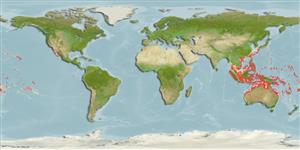Common names from other countries
Classification / Names / Names
Namen | Synonyme | Catalog of Fishes (gen., sp.) | ITIS | CoL | WoRMS
Environment: milieu / climate zone / depth range / distribution range
Ökologie
Riff-verbunden; tiefenbereich 0 - 52 m (Ref. 100896). Tropical; 35°N - 34°S, 95°E - 108°W (Ref. 846)
Indo-Pacific. Tropical to subtropical.
Length at first maturity / Size / Gewicht / Alter
Maturity: Lm ? range ? - ? cm
This is the classic "table" coral, with long-lived colonies forming tables several metres in diameter. The coral is supported by a central stalk; the main braches anastomose in the horizontal plane, while secondary branchlets all grow vertically to the same height, forming a flat surface (Ref. 269).
Common at shallow to intermediate depths throughout its range (Ref. 269). Upper reef slopes; outer reef flats (Ref. 846). Has very high bleaching level and estimated mortality nearing 100% in Palau (Ref. 66144).
Life cycle and mating behavior
Geschlechtsreife | Fortpflanzung | Ablaichen | Eier | Fecundity | Larven
Hermaphroditic (Refs. 97272, 113708, 113712).
Hodgson, G. 1998. (Ref. 269)
IUCN Rote Liste Status (Ref. 130435)
CITES Status (Ref. 108899)
Not Evaluated
Nutzung durch Menschen
| FishSource |
Tools
Internet Quellen
Estimates based on models
Preferred temperature
(Ref.
115969): 24.3 - 29, mean 27.9 (based on 844 cells).
Preiskategorie
Unknown.
